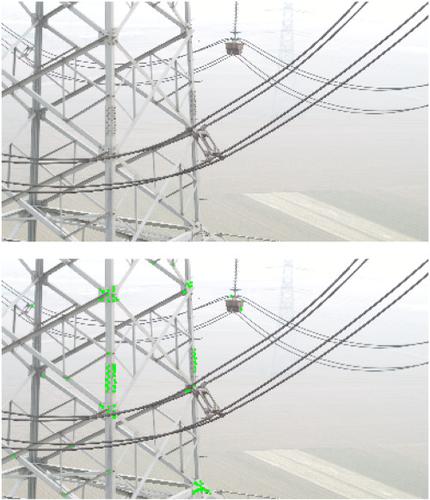当前位置:
X-MOL 学术
›
Int. J. Circ. Theory Appl.
›
论文详情
Our official English website, www.x-mol.net, welcomes your feedback! (Note: you will need to create a separate account there.)
Limited sliding network: Fine‐grained target detection on electrical infrastructure for power transmission line surveillance
International Journal of Circuit Theory and Applications ( IF 2.3 ) Pub Date : 2020-12-03 , DOI: 10.1002/cta.2906 Jing Zhao 1 , Kun Zhang 1 , Zihao Wang 2 , Fengkai Liu 3 , Guanhua Sun 4 , Jinling Chou 5 , Min Xu 5 , Xi Zhang 2 , Xiangdong Liu 2 , Zhen Li 2
International Journal of Circuit Theory and Applications ( IF 2.3 ) Pub Date : 2020-12-03 , DOI: 10.1002/cta.2906 Jing Zhao 1 , Kun Zhang 1 , Zihao Wang 2 , Fengkai Liu 3 , Guanhua Sun 4 , Jinling Chou 5 , Min Xu 5 , Xi Zhang 2 , Xiangdong Liu 2 , Zhen Li 2
Affiliation

|
Because of its small size, low local contrast, and much interference, the field image of fine‐grained equipment taken from power transmission line surveillance is hard to be sustained by the traditional small target detection technique, which requires the manual extraction of features, making it difficult to accurately detect micro‐fine‐grained equipment. The deep learning‐based algorithms have prospective application but require abundant data to guarantee performance and tackle the problem of foreground–background imbalance. This paper develops an effective pipeline, i.e., limited sliding network (LSNet), to detect the small and fine‐grained defects on equipment in power transmission line infrastructure. The model firstly performs the regional analysis on the entire image to determine the potential target locations. The feature extraction and classification on the potential location image blocks are further performed by the VGG‐style model for the dense target locations, and the nonmaximum suppression method is finally applied to locate the target. On the other hand, a specific training method is also developed to better deal with a wide range imbalances of positive and negative samples. The proposed method achieves the detection mean average precision (mAP) rate of 98.66% on the real datasets, while limiting the computational overhead of hardware.
中文翻译:

有限的滑动网络:电力基础设施的细粒度目标检测,用于输电线路监控
由于其体积小,局部对比度低,干扰多,因此传统的小目标检测技术难以维持输电线路监控中的细颗粒设备的现场图像,而传统的小目标检测技术需要人工提取特征,使得很难精确检测出微细粒度的设备。基于深度学习的算法具有前瞻性应用,但需要大量数据才能保证性能并解决前景与背景之间的不平衡问题。本文开发了一种有效的管道,即有限滑动网络(LSNet),以检测输电线路基础设施中设备的细小缺陷。该模型首先对整个图像进行区域分析,以确定潜在的目标位置。通过VGG样式模型对密集目标位置进一步执行对潜在位置图像块的特征提取和分类,最后应用非最大抑制方法来定位目标。另一方面,还开发了一种特定的训练方法,以更好地处理正样本和负样本的各种不平衡情况。所提出的方法在真实数据集上的检测平均平均精度(mAP)率为98.66%,同时限制了硬件的计算开销。还开发了一种特定的训练方法,以更好地处理正负样本之间的广泛不平衡。所提出的方法在真实数据集上的检测平均平均精度(mAP)率为98.66%,同时限制了硬件的计算开销。还开发了一种特定的训练方法,以更好地处理正负样本之间的广泛不平衡。所提出的方法在真实数据集上的检测平均平均精度(mAP)率为98.66%,同时限制了硬件的计算开销。
更新日期:2020-12-03
中文翻译:

有限的滑动网络:电力基础设施的细粒度目标检测,用于输电线路监控
由于其体积小,局部对比度低,干扰多,因此传统的小目标检测技术难以维持输电线路监控中的细颗粒设备的现场图像,而传统的小目标检测技术需要人工提取特征,使得很难精确检测出微细粒度的设备。基于深度学习的算法具有前瞻性应用,但需要大量数据才能保证性能并解决前景与背景之间的不平衡问题。本文开发了一种有效的管道,即有限滑动网络(LSNet),以检测输电线路基础设施中设备的细小缺陷。该模型首先对整个图像进行区域分析,以确定潜在的目标位置。通过VGG样式模型对密集目标位置进一步执行对潜在位置图像块的特征提取和分类,最后应用非最大抑制方法来定位目标。另一方面,还开发了一种特定的训练方法,以更好地处理正样本和负样本的各种不平衡情况。所提出的方法在真实数据集上的检测平均平均精度(mAP)率为98.66%,同时限制了硬件的计算开销。还开发了一种特定的训练方法,以更好地处理正负样本之间的广泛不平衡。所提出的方法在真实数据集上的检测平均平均精度(mAP)率为98.66%,同时限制了硬件的计算开销。还开发了一种特定的训练方法,以更好地处理正负样本之间的广泛不平衡。所提出的方法在真实数据集上的检测平均平均精度(mAP)率为98.66%,同时限制了硬件的计算开销。



























 京公网安备 11010802027423号
京公网安备 11010802027423号